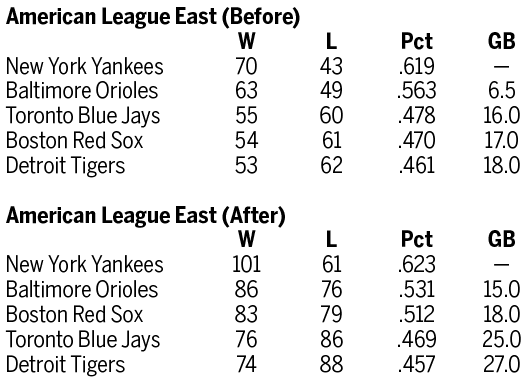
- 1994 mlb strike interview how to#
- 1994 mlb strike interview Patch#
- 1994 mlb strike interview professional#
You can get more forceful if I’m doing it wrong.’ He very much humbled himself to say, ‘I am the low man on the totem pole,’” Huff says. “The first couple times when I sheepishly said, ‘Mike, that wasn’t very good, let’s do it again,” he would look at me and say, “It’s okay, Huffie.

But that winter, Huff says that Jordan asked to be on the opposite end of such pressure. The Last Dance covers Jordan’s near-maniacal competitiveness, which sometimes bordered on bullying lesser Bulls players in order to motivate them during practice.
1994 mlb strike interview Patch#
“They would be bleeding, and we’d have to patch them up.” “He would hit and hit and hit until literally there were blisters on his hands,” Schneider recalls. They would often have to nearly drag him off the field after a long day of practicing his swing or chasing fly balls. “He had basketball athleticism and basketball IQ, but there was really none of that baseball-wise.”īut Jordan quickly won over Huff and Schneider with his determination to learn and improve. “It was pretty rough at the beginning,” Huff says. It didn’t help matters that Jordan’s baseball skills were raw.
1994 mlb strike interview how to#
“As a backup outfielder, it was a little bit unnerving to have the chairman ask you to teach someone how to do your job,” Huff recalls. Huff initially bristled at Reinsdorf’s request. Once Jordan had bulked up, Huff and former White Sox slugger Bill Melton were recruited to teach Jordan baseball fundamentals in all-day training sessions at Comiskey Park and the nearby Illinois Institute of Technology.

“He was putting stresses on joints in a way he had never done, maybe other than high school,” Schneider says. Weeks before he picked up a bat or a glove, Schneider had Jordan do weeks of weight lifting and conditioning to strengthen his shoulders, elbows and hands. Without telling anyone else, Jordan and Schneider got to work the day after Thanksgiving to transform his basketball body into a baseball one. He quietly told his plan to Jerry Reinsdorf, who was the owner of both the Bulls and the White Sox the owner agreed to help him and gave his number to the longtime White Sox trainer Herm Schneider. After his father’s death, Jordan needed an emotional reset, and he became even more motivated to fulfill his longtime ambition.

1994 mlb strike interview professional#
There actually was a shred of logic to the gimmick at this point-that a professional athlete not having the opportunity to play his sport might try his hand in another athletic endeavor, and particularly one in which he could take out some frustrations via physical violence.In The Last Dance, Jordan says that one of the last things his father had told him was to follow his childhood dream of becoming a baseball player. WWE opted to bring it back in 1994 though, when Major League Baseball went on strike. The character actually got its start in 1993 under the moniker MVP (no relation to the eventual Montel Vontavious Porter) but didn’t get much traction. As Prichard recalled it, his premise was as simple as painting his face to look like a baseball and going out to wrestle.

In this case, though, the often under-appreciated journeyman wrestler Lombardi was the driving creative force. Lombardi was most famous wrestling as The Brooklyn Brawler and would also have noteworthy points playing Kamala’s handler Kim Chee as well as a version of Doink the Clown. From an account on Something To Wrestling with Bruce Prichard the original idea for a baseball-playing wrestler came straight from the man who would ultimately portray the gimmick-legendary enhancement worker Steve Lombardi.


 0 kommentar(er)
0 kommentar(er)
